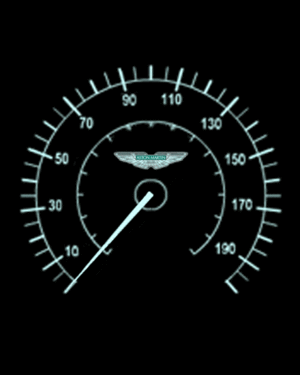Saturday, December 8, 2012
0
Originally patented by a German, Otto Schulze on 7 October 1902,[2] it uses a rotating flexible cable usually driven by gearing linked to the output of the vehicle's transmission. The early Volkswagen Beetle and many motorcycles, however, use a cable driven from a front wheel.
When the car or motorcycle is in motion, a speedometer gear assembly will turn a speedometer cable which then turns the speedometer mechanism itself. A small permanent magnet affixed to the speedometer cable interacts with a small aluminum cup (called a speedcup) attached to the shaft of the pointer on the analogue speedometer instrument. As the magnet rotates near the cup, the changing magnetic field produces eddy currents in the cup, which themselves produce another magnetic field. The effect is that the magnet exerts a torque on the cup, "dragging" it, and thus the speedometer pointer, in the direction of its rotation with no mechanical connection between them.[1]
The pointer shaft is held toward zero by a fine torsion spring. The torque on the cup increases with the speed of rotation of the magnet (which is driven by the car's transmission). Thus an increase in the speed of the car will twist the cup and speedometer pointer against the spring. The cup and pointer will turn until the torque of the eddy currents on the cup is balanced by the opposing torque of the spring, and then stop. Since the torque on the cup is exactly proportional to the car's speed, and the spring's deflection is proportional to the torque, the angle of the pointer is also proportional to the speed. At a given speed the pointer will remain motionless and pointing to the appropriate number on the speedometer's dial.
The return spring is calibrated such that a given revolution speed of the cable corresponds to a specific speed indication on the speedometer. This calibration must take into account several factors, including ratios of the tailshaft gears that drive the flexible cable, the final drive ratio in the differential, and the diameter of the driven tires.
modern speedometer
Eddy current
The eddy current speedometer has been used for over a century and is still in widespread use. Until the 1980s and the appearance of electronic speedometers it was the only type commonly used.Originally patented by a German, Otto Schulze on 7 October 1902,[2] it uses a rotating flexible cable usually driven by gearing linked to the output of the vehicle's transmission. The early Volkswagen Beetle and many motorcycles, however, use a cable driven from a front wheel.
When the car or motorcycle is in motion, a speedometer gear assembly will turn a speedometer cable which then turns the speedometer mechanism itself. A small permanent magnet affixed to the speedometer cable interacts with a small aluminum cup (called a speedcup) attached to the shaft of the pointer on the analogue speedometer instrument. As the magnet rotates near the cup, the changing magnetic field produces eddy currents in the cup, which themselves produce another magnetic field. The effect is that the magnet exerts a torque on the cup, "dragging" it, and thus the speedometer pointer, in the direction of its rotation with no mechanical connection between them.[1]
The pointer shaft is held toward zero by a fine torsion spring. The torque on the cup increases with the speed of rotation of the magnet (which is driven by the car's transmission). Thus an increase in the speed of the car will twist the cup and speedometer pointer against the spring. The cup and pointer will turn until the torque of the eddy currents on the cup is balanced by the opposing torque of the spring, and then stop. Since the torque on the cup is exactly proportional to the car's speed, and the spring's deflection is proportional to the torque, the angle of the pointer is also proportional to the speed. At a given speed the pointer will remain motionless and pointing to the appropriate number on the speedometer's dial.
The return spring is calibrated such that a given revolution speed of the cable corresponds to a specific speed indication on the speedometer. This calibration must take into account several factors, including ratios of the tailshaft gears that drive the flexible cable, the final drive ratio in the differential, and the diameter of the driven tires.
Subscribe to:
Post Comments (Atom)









0 Responses to “modern speedometer”
Post a Comment